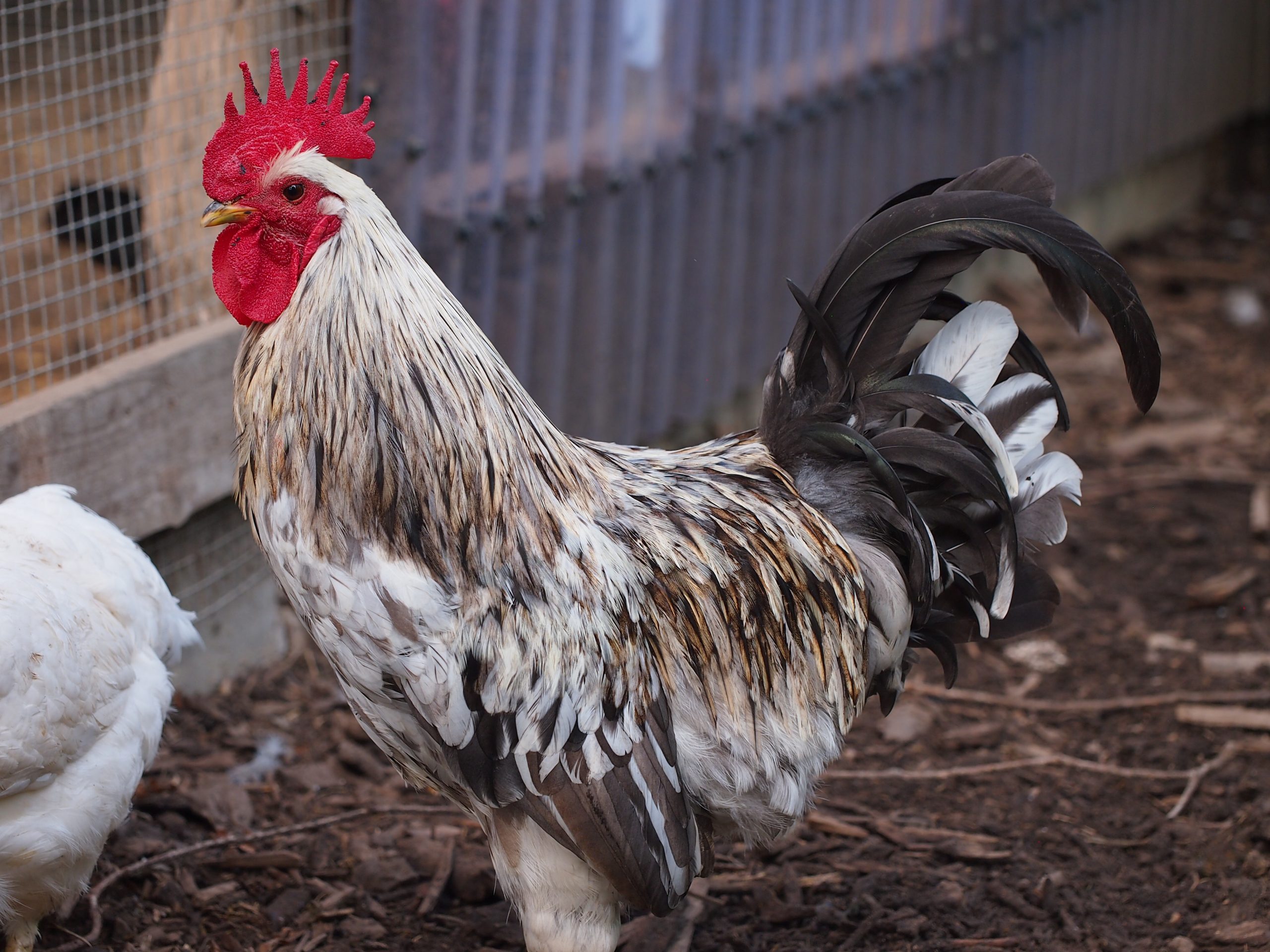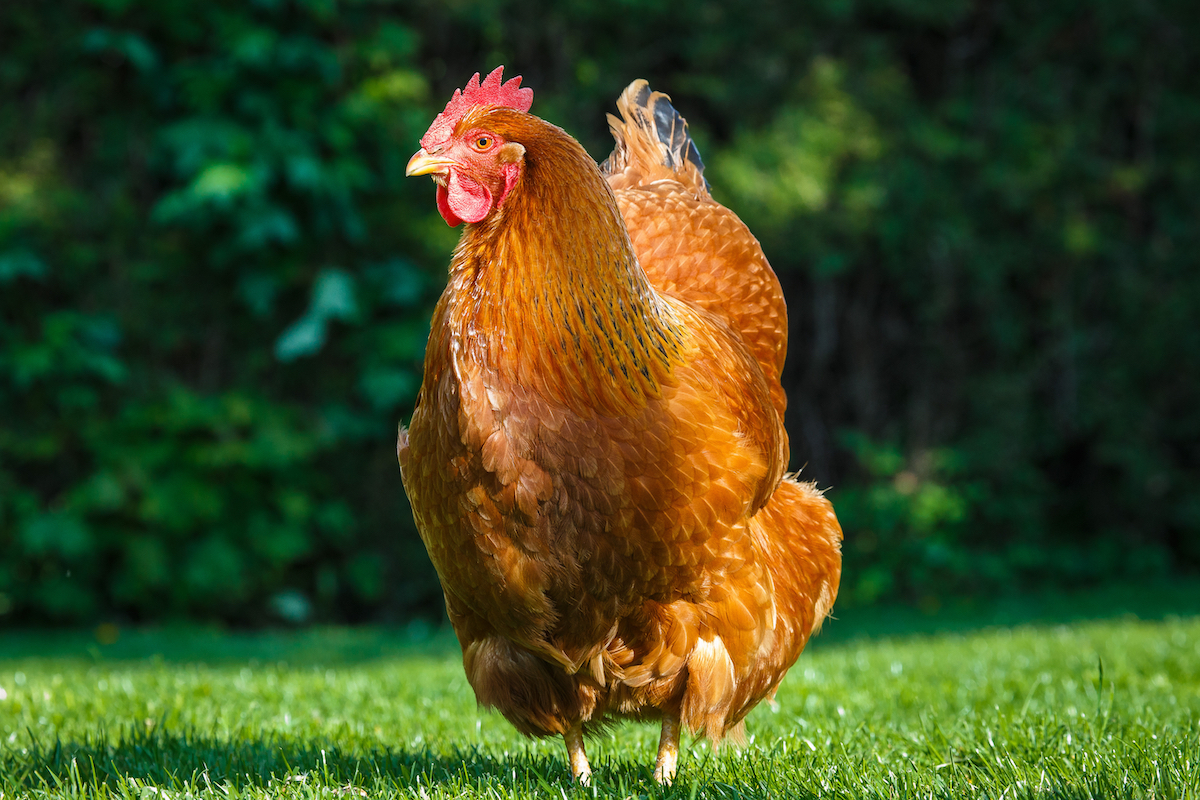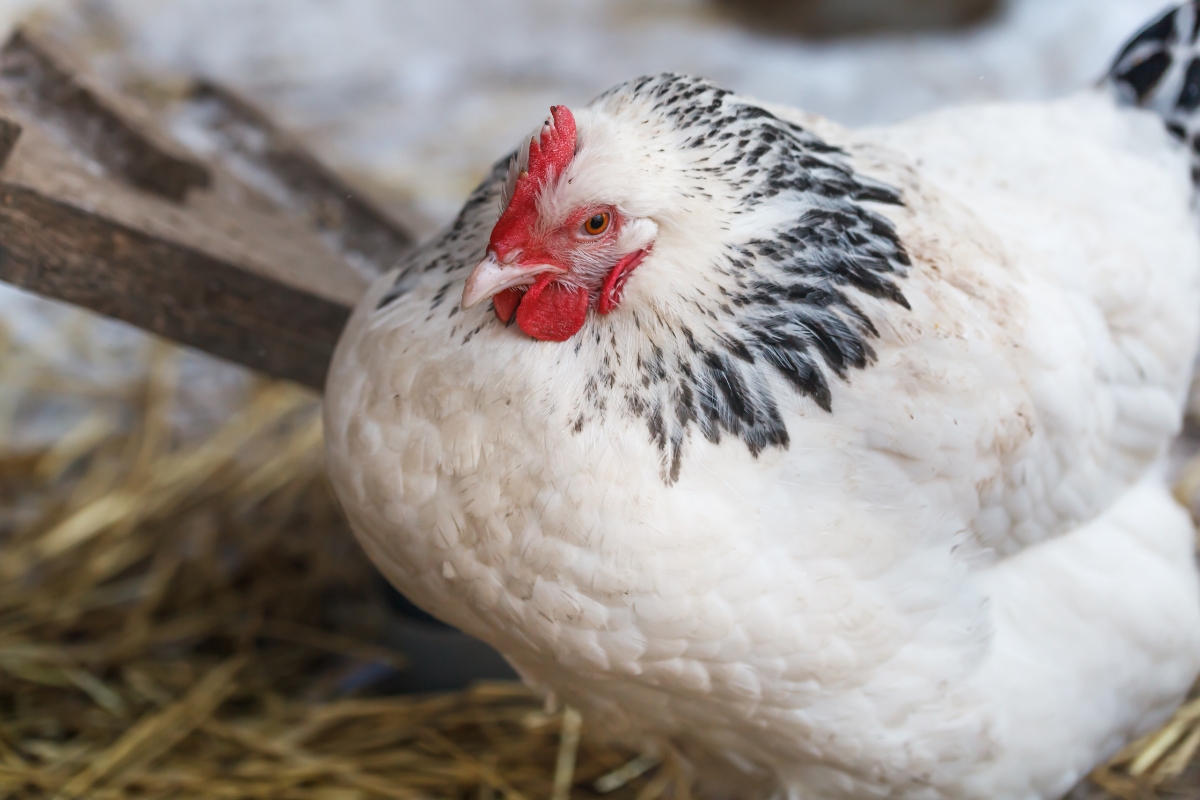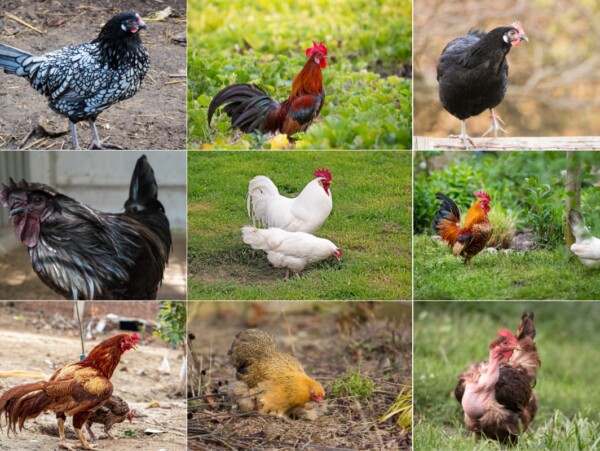Affiliate disclosure: This post may contain affiliate links. Please see our Privacy Policy.
Broody chicken breeds can hatch and raise their own chicks, and their one of the best ways to ensure a self-sustaining flock. Broodiness is more common in heirloom chicken breeds, where the trait has been passed down for generations.

These days, most chicks are raised in incubators, and many modern chicken breeds have lost the drive to “go broody.” They simply won’t set on eggs or mother chicks, and those breeds are only propagated with incubators (or the help of a broody hen from an heirloom breed).
Most articles you find concerning broody hens are all about how to discourage a broody hen, as honestly, it’s inconvenient to have a cranky hen trying to stop you from taking their eggs. Normally, hens don’t really care if you take their eggs each day, provided you feed them, but a broody hen will fight to keep her clutch.
Some breeds, especially heirloom breeds, are more prone to broodiness than others. If you hope to have a hen raise chicks in your coop, you should opt for one of these broody chicken breeds to help ensure success.
In an ideal circumstance, a few broody hens can maintain a poultry flock indefinitely, without having to spend money on new chicks every few years.
What is a Broody Hen?
Broody hens are hens that want to incubate eggs and raise them into chicks. Not all chickens are broody, and even “broody” chickens aren’t broody all the time. Broodiness is a hormonal state that a hen enters when she’s ready to incubate eggs, and it comes with elevated body temperature, defensive behavior and a whole host of other behaviors that will help her raise a clutch of eggs into chicks.
If a chicken is not broody, she will not raise chicks even if they’re left in the nest and even if she’d otherwise be a good mother. If she’s not in that hormonal state, it’s just not going to happen.
What Makes a Hen Go Broody?
There is no clear answer as to why a hen goes broody, and she’ll even sit on unfertilized eggs if that’s all she has. It is most likely a combination of maturity, instinct, lighting, genetics, and hormones, but some chickens are more prone to becoming broody than others.
Broodiness is passed down in certain chicken breeds, especially heritage breeds that still have many of their natural instincts.
What Happens When a Hen Gets Broody?
One of the first signs of a broody hen is that she refuses to leave her nest box and fusses at you every time you get near her. Once you seen it for the first time, you won’t have to wonder about broodiness the second time.
Some hens pluck out their breast feathers to prepare to keep the eggs warmer when she sits on them. They puff up and become territorial over their space, and she will bite and peck you if you attempt to move her!
How Many Eggs Can a Chicken Hatch?
A full-sized chicken can hatch around ten eggs dependably, but up to 14-16 with mixed success.
Bantam chickens are best for hatching bantam eggs because both the chicken and the egg are smaller. When hatching bantam-sized eggs, a bantam hen can hatch as many eggs as a full-sized hen, or about ten in a clutch.
Broody Hen or Incubator: Which is Better?
There are many arguments for and against using a broody hen to raise eggs. It certainly is easier to leave the eggs with a broody hen, and you don’t have to fuss over the eggs (she’ll do that for you).
Broody hens are generally less dependable than incubators, as they sometimes just abandon the nest for seemingly no reason. You are literally at the whims of that particular individual hen.
Provided you have electricity and fertile eggs, an incubator will get the job done without a hitch. Everyone has their own preference, and I don’t think there’s a right or wrong answer.
If you can’t get a hen to do the job, Brinsea incubators are some of the best, and their Automatic 24 Egg Incubator is a great fit for most people. (If you’re only doing a few eggs at a time, their Automatic 7 Egg Incubator will get the job done too.)
Broody Chicken Breeds
While broodiness has been largely bred out of modern chicken breeds, there are still quite a few heirloom chicken breeds that can readily hatch their own chicks and make excellent mothers.
Broody Full sized Chicken Breeds Include:
- Bielefelder
- Brahma
- Chantecler
- Cochins
- Deleware
- Dorking
- Isbar
- Icelandic
- Java
- Kraienkopp
- Marans
- New Hampshire Red
- Orpingtons
- Plymouth Rock
- Silkie
- Sussex
Broody Bantam Chicken Breeds Include:
- Belgian Barbu d’Anvers
- Belgian Barbu d’Uccle
- Bantam Cochins
- Bantam Brahmas
- Dutch Booted Bantams
- Dutch Bantam
- Nankin Bantams
- Old English Game
- Peking Bantam
- Silkie Bantams
Here’s what you need to know about each of these broody chicken breeds:
Bielefelder
An heirloom chicken breed from Germany, the Bielfelder is one of the friendliest chicken breeds. The roosters will defend the flock from predators, but they also won’t hesitate to crawl into your lap for scritches.
Bielefelder hens are exceptionally broody, and excellent mothers. They’re known to incubate and hatch extra-large clutches of eggs, likely due to their large body size.
Their large body size (10 lbs for hens, and 13 lbs for roosters) means they’re the perfect dual-purpose chicken, and they lay a respectable 230 to 280 extra large eggs per year.

Brahma
As the second largest breed of chicken, second only to the Jersey Giant, you might be surprised to find the Brahmas lay regular size eggs. They are extremely friendly, beautiful, cuddly, and calm.
While these hens lay fewer eggs than many other breeds, their docile nature makes broodiness a pleasure for everyone involved. In addition, because they’re so large, they can hatch more eggs and are excellent mothers.
A Brahma rooster can stand as tall as 30 inches, with hens standing at about 18 inches, and the hens will reach roughly 8 pounds when fully grown. Also, as a dual-purpose chicken, they will lay about 150 large eggs a year.

Chantecler
Chanteclers originated in Canada in the early 20th century, but these cold-hardy chickens are considered critical today and need preservation. They’re bred from White Leghorns, Rhode Island Reds, White Plymouth Rocks, White Wyandottes, and Dark Cornishes and are recognized by the APA’s Standard of Perfection.
Chanteclers are known for laying well, even in the winter, but they’re still prone to broodiness. This is where their personable personalities come into play, making for great mothers and companion chickens as well.
Hens will weigh about 5 pounds to the rooster’s 9 pounds, and their plumage is right against their bodies. They lay well, and production never wanes throughout their lifetime. You can expect about 150 to 200 eggs per year until she decides to go broody.

Cochins
Bred initially in China and exported to America and Britain in the 19th century, you’ll know Cochins by their distinctive feathering and colorations, with feathered feet. These rare chickens are bred to show and have a docile, gentle, and quiet personality.
Cochins’ broodiness leads to an excellent mothering instinct, making them a perfect foster mom to other breeds. In addition, they’re noted as one of the easiest birds to tame, making them an excellent choice for homes or farms with children.
Weighing in at about 8 to 11 pounds, these girls will lay 150 to 180 medium-sized brown eggs yearly.

Delaware
In the 1940s, the Delaware chickens became the new breed in town, bred for the broiler industry, which didn’t work out. They almost became a forgotten breed, but the chickens are gorgeous dual-purpose birds with calm personalities.
The Delawares are sometimes broody and sometimes not, but they are exceptional mothers when they are. They are very curious and intelligent, so expect to see them around trying to figure out everything you do.
Roosters commonly range from 7 to 8 pounds, with hens weighing about 6 pounds, and they lay about 4 jumbo brown eggs each week.

Dorking
Dorkings are rare and endangered, so birds with white coloring may be impossible to find. However, they are said to date back to as early as 43 AD, taking the title of one of the oldest chicken breeds currently known.
These hens go broody fast and raise their chicks very well, including adopted chicks that aren’t theirs. They also care for their clutch long after other chicks have left their mother’s care.
Considered one of the most flavorful and delicious chickens, these dual-purpose breeds offer up to 190 medium to large eggs with a light brown tint.

Isbar
An Isbar is a cross between a New Hampshire and a Rhode Island Red, originally crossed in the 1980s. Various genetic combinations can create a range of different colors, including blue, splash, and black, but they do not breed true to color.
Isbars lay about 200 eggs yearly with a minty, moss-green tint.
Roosters will be about 5 pounds, with hens weighing just over three pounds, and although roosters are incredibly docile, they will not back down when facing a predator. They’re great foragers and are cold-hardy too.

Icelandic
As the name suggests, Icelandic chickens are initially from Iceland, dating back to the tenth century. They are small, weighing 3 to 5 pounds for hens and roosters, respectively, but they forage exceptionally well.
These lively little birds are quick to go broody and have excellent mothering skills. Of course, not all your hens will go broody, but those that do will readily replenish your flock.
These birds lay about 150 large white or light beige eggs and offer the dual-purpose benefits you might expect. Their flesh is fine-grained and extremely tasty.

Java
Java chickens are the second oldest American breed, said to be imported from the Far East Isle of Java by 1850. The beautiful birds are calm, friendly, perfect for being around children, and they get along well with other chickens.
They are well known for their broodiness, with excellent mothering skills, and will average 180 large eggs a year, with tinted to dark brown eggs. They lay well in the winter for the entirety of their 5-to-8-year lifespan.
As a dual-purpose chicken, males weigh up to 10 pounds, while hens weigh 7 to 8 pounds. You’ll appreciate four distinct colors, a single comb, and yellow foot soles.

Kraienkoppe
These birds are hardy and actively forage, so they are best served in a free-range environment where they can thrive. They are relatively good-natured but can be a little flighty if they find it necessary.
Hens don’t mind laying in the wintertime and are more than happy to go broody. Their mothering skills are excellent, and they easily replenish the flock.
Kraienkopps will lay 150 to 180 medium off-white eggs a year, but they aren’t a dual-purpose breed. You’ll appreciate the eggs far more than meat with these chickens.
Marans
Marans are noteworthy for their dark brown eggs, friendly demeanor, and toleration of confinement. But they’re also excellent for mixed-breed flocks if you want to commit to the breed.
These birds are as sought-after as pets as they are for eggs and meat, and there’s a good chance you’ll wind up with a broody hen. However, if you have hens that aren’t inclined to broodiness, you can easily tempt them in that direction.
They only lay 100 to 150 eggs a year, with that rich, brown color, but when they go broody, it’s worth it. They’ll weigh 8 pounds for roosters, and 6 pounds for hens, with wide coloring varieties.

New Hampshire Red
New Hampshire Reds are versatile, valuable, and triple-purpose, but they’re often overlooked for some reason. They’re genetically strong for meat and eggs and a perfect backyard pet that isn’t lazy, flighty, or unhealthy.
These hens are moderately broody but don’t take it to excess. So, though it is a tendency, you may have several who become mothers with a stark devotion to their chicks, while others may not go broody.
You can expect 3 to 4 eggs each week, or up to 200 per year, with those bred strictly for meat purposes laying fewer eggs through the year. However, they’ll continue to lay eggs, even when conditions aren’t perfect.

Orpingtons
Known as the “model” English hen, Orpingtons are dual-purpose chickens that are great for eggs and meat. They’re fluffy, well-built, and docile, making them the perfect family bird, even for first-time owners.
If you reply on all your hens for egg production, their rate of broodiness might be a problem. Otherwise, these birds will be devoted mothers, giving lots of attention to their chicks and ensuring they fit the flock well once grown.
Weighing in at around 8 pounds, Orpingtons can lay as many as 280 eggs or more each year, featuring a large size and a light brown color. So occasionally, you may see a medium egg, but never anything less.

Plymouth Rock (Barred Rock)
Plymouth Rocks are another breed with a long American history and some of the sweetest chickens you’ll find. They especially love to be held and may even ask for extra attention when you’re working outside.
These hens are incredibly likely to go broody, and when they do, they are fabulous mothers who care deeply for their chicks. In addition, many homesteaders appreciate that they are a quieter breed that works well when you live close to others.
Plymouth Rocks lay large, high-quality brown eggs, and their production never slows down, as with some other breeds. They can lay as soon as 18 weeks of age and produce up to 300 eggs yearly.

Silkie
Silkies are perfect for the backyard flock because their disposition is so sweet and friendly, but if introduced to an existing flock, they could be bullied. Their distinctive, fluffy appearance is easy to see, but they also require special care that isn’t necessary for other chickens. Therefore, studying the breed before choosing them for your flock is worth your time.
It’s fair to say that the Silkie is the broodiest chicken in the world because she will even go broody if there are no eggs to sit on. However, when she has eggs under her, nothing will phase her or take her off the nest, so she’s the perfect chicken for hatching all your fertile eggs.
These birds can live over 9 years and will lay about 100 small white eggs with a delicious flavor. Of course, you’d get more eggs out of them, but they spend most of their time sitting on and trying to hatch any egg they find!

Sussex
Sussex chickens are an old breed, native to England, that has been around for more than 1,000 years. They are docile, friendly, and intelligent and come in several colors, including the ever-popular speckled variety.
Broodiness is a common trait for this breed, and they are excellent mothers. So if you’re looking to increase your flock, this is a great breed choice.
Their eggs are large and light brown, and they lay an average of 200 a year. In fact, when they lay their eggs is about the only time you’ll hear them make a sound other than alarm calls.

Broody Bantam Chicken Breeds
The first thing you’ll notice about bantams is that they are cuties that are prized pets for most families. They’re perfect with other pets and children, and they love human company, being held, and being cuddled.
Belgian Barbu d’Anvers
These birds are true bantam, which means there are no larger counterparts, as you’ll find with many of the bantam breeds. Instead, these gorgeous little birds only come in tiny sizes, offering all their beauty and benefits.
It’s almost certain that these chickens will go broody at some point, and they make fantastic mothers, carefully guarding their clutch.
They lay an average of 150 small white eggs a year and can start laying by 20 weeks of age. They can live to be 6 to 8 years old and are pretty hardy in all seasons.
Belgian Barbu d’Uccle
This is another excellent chicken if you’re looking for a Bantam breed that loves people. They’re good-natured, especially with children, and won’t wander offer, so they’re a great choice in small gardens or backyards.
These Bantams are best known for their broodiness because they go broody easily and are great mothers once the chicks hatch. They love the opportunity to nest, and their distinctive feathers help keep the eggs warm until they hatch.
You can expect about 100 eggs a year from these Bantams, so they’re perfect if you’re not looking for huge egg production.
Bantam Cochins
These sweeties make “fluffy” an understatement! Tiny, adorable, sweet, and quirky are just a few words to describe the Bantams.
It’s a sure thing these tiny Cochins will go broody, and they’ll do so often. They’ll also sit on their own eggs or eggs from pheasants and ducks. They’re hard to break and could go broody more than once a year.
Bantam Brahmas
Dwarfed Brahmas are an old breed that started in England, failed there, but became popular in Germany. And even though these friendly, docile birds are larger than most Bantams, they lay smaller eggs.
Broodiness is expected in this breed, and when they sit, they sit very determinedly until their chicks hatch. So if you’re looking to increase your flock quickly, this is an excellent way to do it.
These hens weigh about 34 ounces and lay between 130 and 150 small light brown eggs yearly. They lay throughout the winter when they’re not choosing broodiness.

Dutch Booted Bantams
Dutch Booted Bantams are ornamental birds that steal the show at exhibitions, with five beautiful APA-recognized colors and a distinct build. The birds are friendly, calm, and perfect for children and families.
Booted Bantams will definitely go broody, though they don’t hatch very many chicks at one time. However, when they do hatch their clutches, they’re great mothers and care for their young diligently.
With roosters averaging a weight of 26 ounces and hens of 22 ounces, the hens lay about 160 creamy white eggs yearly. They could lay more if they weren’t going broody so often.
Dutch Bantam
Dutch Bantams are another “true” Bantam breed, with no standard sizes available, and they’re noticeably smaller than other Bantams. But they have a great demeanor, so they’re easy to keep, even with children, chickens, and pets.
This breed is known for broodiness and sitting on eggs, but they’re one of the more protective mother hens. Even if you hatch chicks in an incubator, the mother hen will be just as attentive to them as if she hatched them herself.
These chickens have a medium egg productivity, laying 150-160 eggs yearly. These tiny white eggs are about the same size as a pheasant egg but just as tasty as a standard chicken egg.
Nankin Bantams
As one of the oldest true Bantam breeds, the Nankin originates around Southeast Asia but has been a favorite in England since the 1500s. Unfortunately, they don’t do well in Northern climates in the United States because they are prone to frostbite.
The Nankin hen often goes broody and is a remarkable mother, thanks partly to a friendly, calm demeanor and slow maturation rate. Chicks are easy to look after because they don’t often wander far, even when free ranging.
These chickens can live for up to 8 years, and hens lay about 3 to 6 eggs weekly. As a dual-purpose chicken, you’ll appreciate them on your small-scale farm.
Old English Game
Old English Game chickens are well-known for their courage and spirit, with roosters being very territorial against other roosters and predators. However, they are excellent free rangers, especially for smaller spaces.
These hens lay very well but are a reliable choice for a broody hen, becoming devoted and attentive mothers. And where many chickens that go broody are no longer viable egg layers, these still continue to lay well after raising their chicks.
These birds can live up to 16 years, with roosters weighing 24 ounces and hens weighing 22 ounces.
Peking Bantam
Peking Bantams are true Bantams that are purely ornamental breeds for exhibition purposes only. They’re incredibly easy to keep, with a friendly, easygoing demeanor and a wide range of colors.
Hens are regularly broody, sit well more than once a year, and become attentive mothers. They lay up to 160 small eggs each year.
Silkie Bantams
The lap kitten of the chicken population, ornamental Silkie Bantams are some of the most popular birds for small-scale chicken keepers. They are notable for black skin, black bones, and five toes instead of the four typically seen in these birds.
Silkie Bantams are good egg layers, providing about three each week, but they’re also noted for their broodiness and what their mothering abilities.
Least Broody Chicken Breeds
While I’m particularly fond of raising broody chicken breeds that can maintain their own flock, some people just see broody hens as a nuisance. If you want to avoid broodiness, these are some of the least broody chicken breeds:
- Deathlayer (Westfälische Totleger)
- White Leghorn
- Easter Egger
- Red & Black Star Sex Link
- Rhode Island Red
- ISA Brown
- Golden Comet
- Polish
- Lakenvelder
- Hamburg
- Crevecoeur
- Rosecomb Bantam
- Sebright Bantam
- Ancona
- Andalusian
- Langshan
- Campine
- Minorca
- Sicilian Buttercup
Chicken Keeping Guides
Looking for more chicken-keeping guides?
- How to Raise Baby Chicks into Adult Hens
- Beginner’s Guide to Raising Chickens
- 12 Best Egg Laying Chicken Breeds for Beginners
- How Much Does it Cost to Keep Chickens?
- Beginner’s Guide to Chicken Egg Colors
- What’s the Difference Between a Duck Egg and a Chicken Egg?















1 Comment